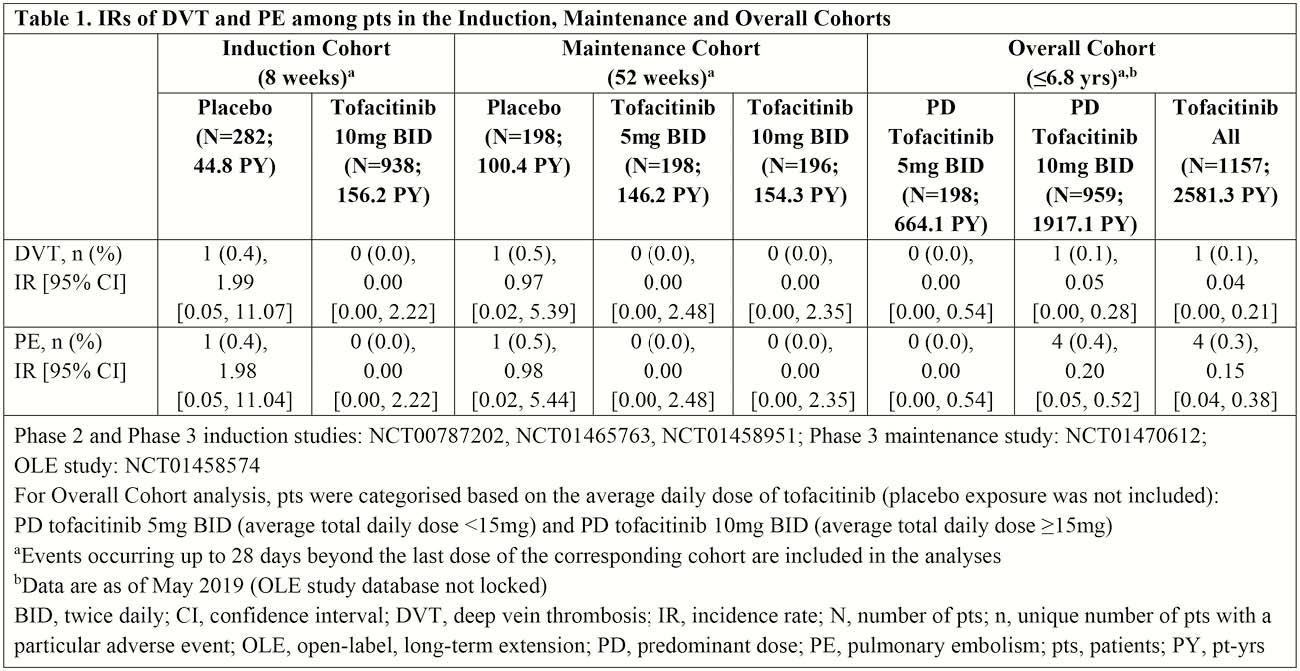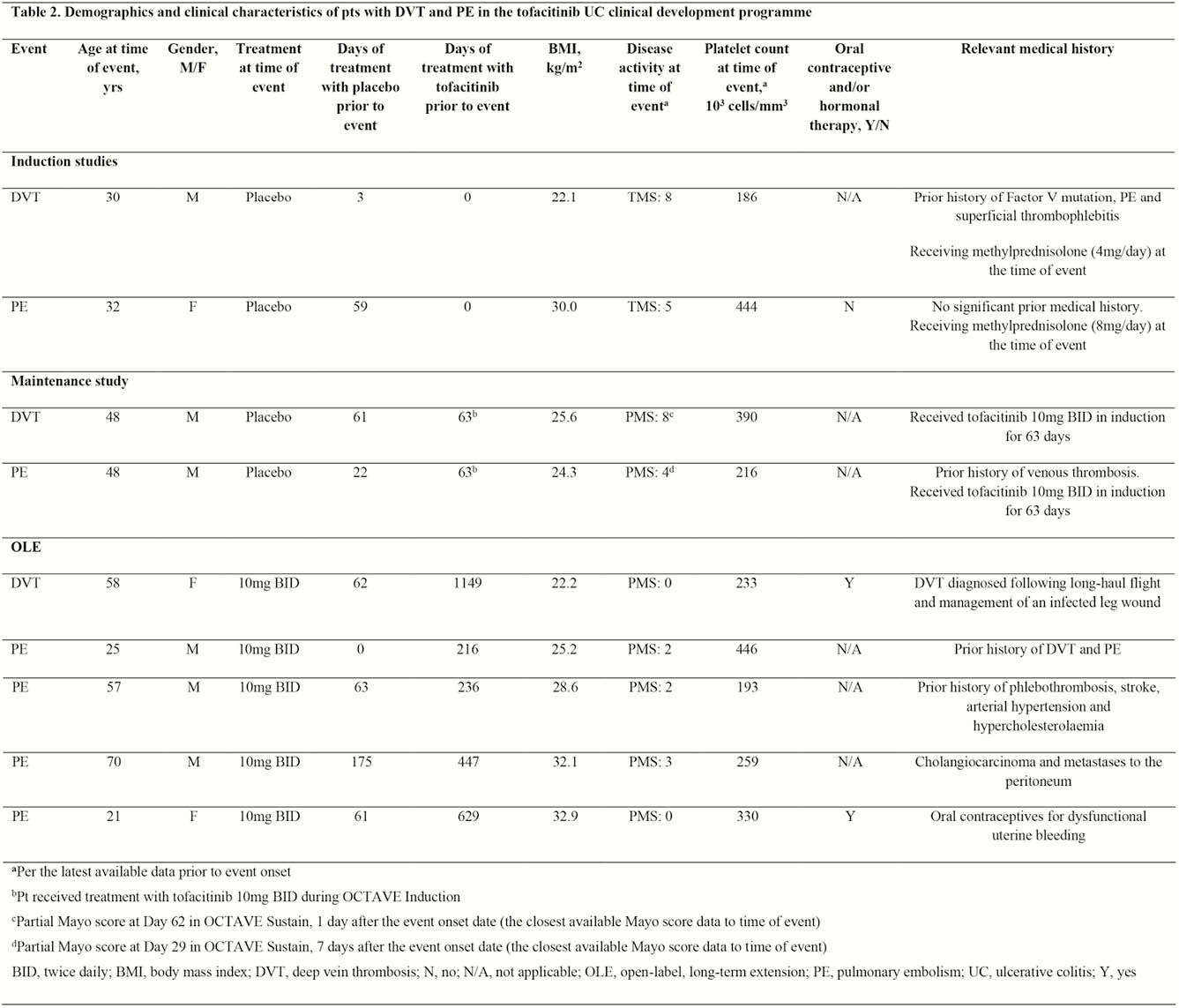P598 Incidence of venous thromboembolic events in patients with ulcerative colitis treated with tofacitinib in the ulcerative colitis clinical development programme: An update as of May 2019
W.J. Sandborn MD1, J. Panés2, B.E. Sands3, W. Reinisch4, I. Modesto5, C. Su6, F. Steinwurz7, N. Lawendy6, N. Koram5, K. Kwok5, T.V. Jones6, A.J. Thorpe6, D. Quirk6, S. Danese8
1Division of Gastroenterology, University of California, San Diego- La Jolla- California, USA, 2Hospital Clínic de Barcelona- IDIBAPS- CIBERehd, Barcelona, Spain, Spain, 3Dr. Henry D. Janowitz Division of Gastroenterology- Icahn School of Medicine at Mount Sinai, New York, New York, USA, 4Medical University of Vienna, Vienna, Austria, Austria, 5Pfizer Inc., New York, New York, USA, 6Pfizer Inc., Collegeville, Pennsylvania, USA, 7Unit of Inflammatory Bowel Disease- Hospital Israelita Albert Einstein, São Paulo, Brazil, Brazil, 8Humanitas University- IBD Center- Division of Gastroenterology, Rozzano, Milan, Italy
Background
Tofacitinib is an oral, small-molecule JAK inhibitor for the treatment of UC. In data analysed from a large, ongoing (data cut-off February 2019 [a]; database unlocked; data may be subject to change), post-authorisation safety study in patients with RA (≥50 years; ≥1 cardiovascular risk factor; enrolled on a stable dose of MTX), the incidence rate (IRs; unique patients with events per 100 pt-years [PY]) of pulmonary embolism (PE) in patients treated with tofacitinib 10mg BID (0.54 [95% CI] 0.32, 0.87]) was numerically higher compared with 5 mg BID (0.27 [0.12, 0.52]) and statistically different from TNFi (0.09 [0.02, 0.26]). Corresponding IRs for deep vein thrombosis (DVT) were 0.38 (0.20, 0.67), 0.30 (0.14, 0.55) and 0.18 (0.07, 0.39).1 UC is a known risk factor for DVT and PE. Subsequently, updates to the tofacitinib prescribing information have been made, with venous thromboembolism added as a warning and adverse drug reaction. Here, we provide an update on the incidence of DVT and PE in the tofacitinib UC clinical development programme, as of May 2019.2
Methods
DVT and PE events were evaluated from 4 randomised placebo-controlled studies (Phase [P]2/P3 induction studies and P3 maintenance study) and an ongoing, open-label, long-term extension (OLE) study.3,4 Three cohorts were analysed: Induction, Maintenance and Overall (patients receiving tofacitinib 5 or 10mg BID in P2/P3/OLE studies; patients were categorised based on the average daily dose: predominant dose [PD] 5 or 10 mg BID).
Results
1157 patients were evaluated for DVT and PE, with 2581 PY of tofacitinib exposure and up to 6.8 years’ treatment. In the Induction and Maintenance Cohorts, 2 patients had DVT and 2 had PE; all were receiving placebo at the time of the event (tables). In the Overall Cohort, DVT occurred in 1 pt and PE in 4 patients during the OLE study, after ≥7 months of treatment; all patients had received PD 10 mg BID (83% of Overall Cohort received PD 10 mg BID) and had other (non-UC) risk factors for venous thrombosis (tables).


Conclusion
IRs in the Overall Cohort have remained stable since the previously reported data cut.2 All of the events in tofacitinib patients (PD 10 mg BID) occurred during the OLE study and all had other (non-UC) risk factors for thromboembolic events. This analysis is limited by sample size and duration of drug exposure; further study is needed. [a] The tofacitinib 10mg BID arm of the study was discontinued in February 2019 and patients who re-consented and chose to remain in the study were switched to the 5 mg BID arm.
https://www.ema.europa.eu/en/documents/referral/xeljanz-article-20-procedure-annex-iii_en.pdf
Sandborn WJ
Sandborn WJ
Lichtenstein GR


